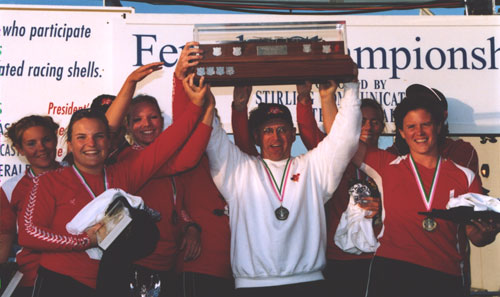Gail Malone, first female on the Regatta Committee
By 1983, the Regatta Committee were ready to recognize the growing role of women in the sport. They appointed their first female member, Gail Malone.
Like so many other members of the committee at the time, her connection to the Regatta was through her family. Gail's father, Gerald B. Malone, was a long time member of the committee and a gunner for the races for many years.
In 1985, the Newfoundland Public Library Service sponsored a crew with Gail and five other library staff. Their crew lost the 6:00pm Ladies Memorial Race - but, like all participants, had great fun rowing!
Being an Honourary Life President of the Regatta Committee, Mr. Gerry Angel was one of Gail's mentors and supporters until his death in 2002.
Within five years of her 1983 appointment, Gail began serving at the executive level. She has had various positions of responsibility over her 20 years on the committee. In 1996, supervised by Mr. Bruce Neal, Gail proudly took over her father's role to become the first female gunner on Regatta Day.
The changing face of the Regatta
The number of women on the committee grew steadily in the years that followed. In 1984, Karen (McKinlay) Thomas became the second woman on the Regatta Committee. Since then, many others have followed: Maureen Dunne, Sharon Dominic, Sharon Tiller, Gert Reardigan, Judi Evans, Ros Devereaux, Zita Dalton, Siobhan Coady, Colleen Galgay-Johnson, Jill Kelly, Amy Crosbie, Stephanie Hickman, Anne Marie Smyth and Judy Stirling. Currently, twelve of the fifty active volunteers on the Committee are women.
In early years, women would row from the bottom of the pond and finish at the start line, without having to make the turn at the buoys. Turning the buoys brought the level of women's rowing on par with the men, as the training and skill levels became more evenly matched. With the women's course now in the middle of the pond and in clear view of the spectators, interest was growing.
The perception that there were always more men than women rowing may have been reinforced by the fact that, for many years, the top 8 and later top 10 male crews rowed twice during the race day schedule. The men rowed the first two races in the morning and the first two races in the afternoon. Consequently, when this was halted in 1999, the actual participation of women rowers became much more obvious.
Women outnumber men
The continued surge of interest in women's competition has helped to improve the quality and increase the number of women's crews. In fact, in recent Regattas, there are up to four times as many womens crews as mens. This means that, in recent years, women's crews make up 70 to 80% of the races held during the Royal St. John's Regatta.
While the popular history of women at the Regatta is fairly new, it would be negligent to make any mention of women's history without looking at some of the impressive performances of the women's crews.
|
One of the most well known women's crews is OZ-FM. In 1994, they set a course record
of 4:59.52, breaking the coveted 5 minute barrier. In 2003, they beat their own
best time by completing the course in 4:56.70 in the first race of the day and
later rowing 4:58.68, setting new records for both races. The 2003 OZ-FM women's
crew consisted of Siobhan Duff, Tracey Hogan, Kristine Power, Jackie Handrigan,
Nicole Hamlyn, Amanda Hancock, and Coxswain Richard Bailey.
|

The OZ-FM Women's crew - Set course record and won women's Championship Race in 2003
(Year: 2003, Size: 43kB, Photographer: Gord King). |
Another of the well known women's crew is the Keyin Tech Women's Crew. In 1997, they won their third straight championship race. They rowed a time of 5:10.30 in the Captain Morgan. The crew consisted of Anne-Marie Tobin, Nancy Little, Carolyn Burry, Diana Hogan, Dawn Hannaford, Williamina Martin, and Coxswain Rick Coish.
OZ-FM vs. Keyin Tech
In 1994, these crews faced off against each other in the Women's Championship Race. The race ended in confusion and left these teams as keen adversaries. As OZ-FM crossed the finish line, they heard the Keyin Tech crew erupt in joyous celebration. Without double checking, OZ-FM assumed defeat and watched as Keyin Tech made their way to the winners dock. It was announced a short time later that OZ-FM finished the race with a time of 4:59.52, and Keyin Tech with a time of 4:59.84, making OZ-FM the winners. The Keyin Tech crew were crushed. Not only had they lost the Championship Race, but also their bid for the Triple Crown of Boat racing - Championship Race wins in the Harbour Grace, Placentia and Royal St. John's Regatta's.
The 1999 Regatta saw womens rowing take another step forward. The Regatta Committee decided that, beginning this year, men's and women's crews would take turns rowing the first two races in the morning.
Over the years, there have been some more subtle changes. For example, in the official programme, the names of the races have been slowly changed from Ladies races to Women's races, and now to Female races.
The women of the Regatta add significantly to the Regatta's development as a sport. The athleticism and commitment of female rowers is an important contribution to the Regatta's competitive spirit.





